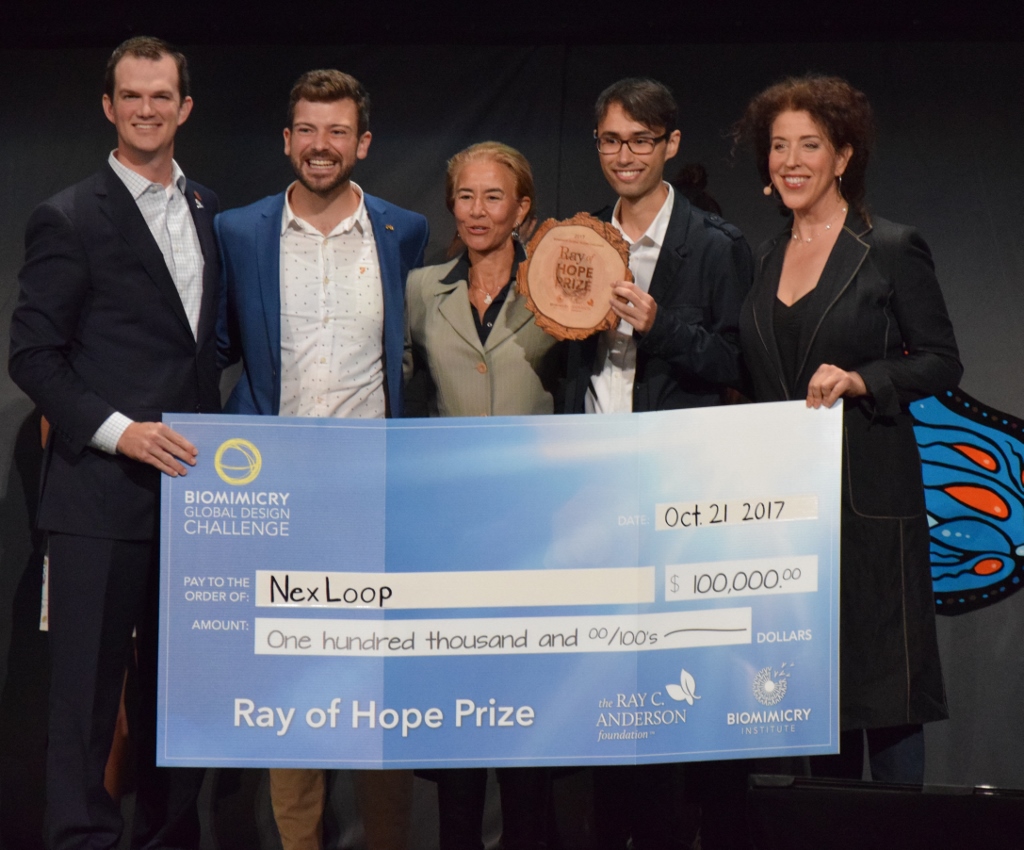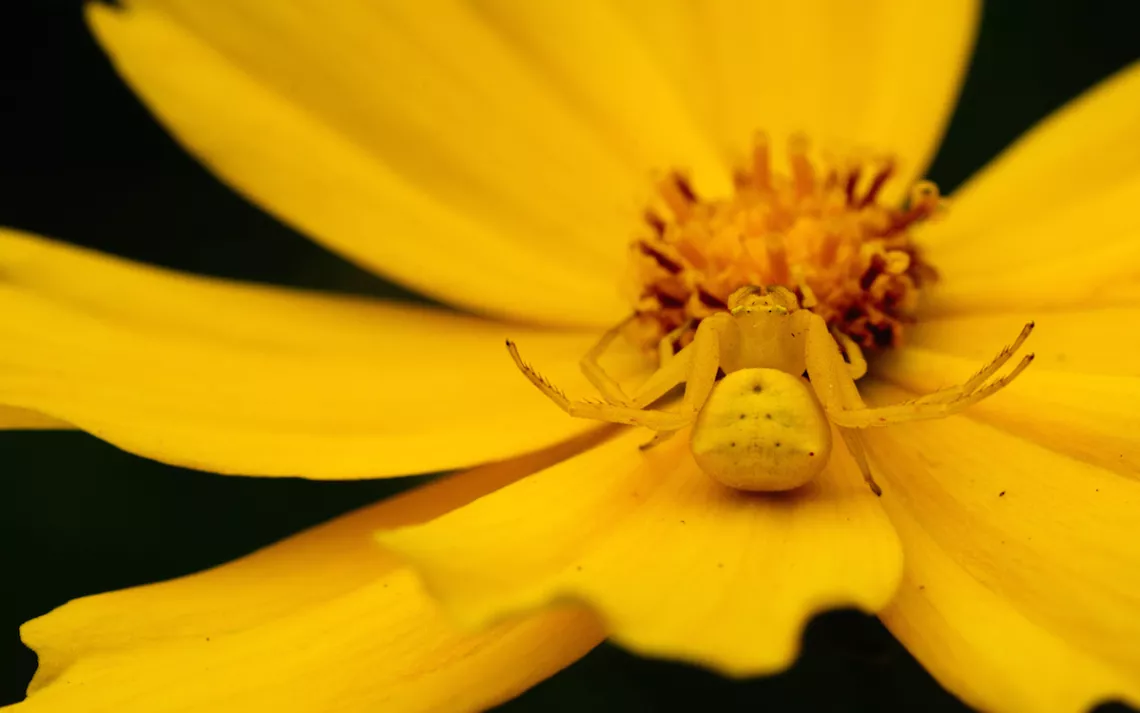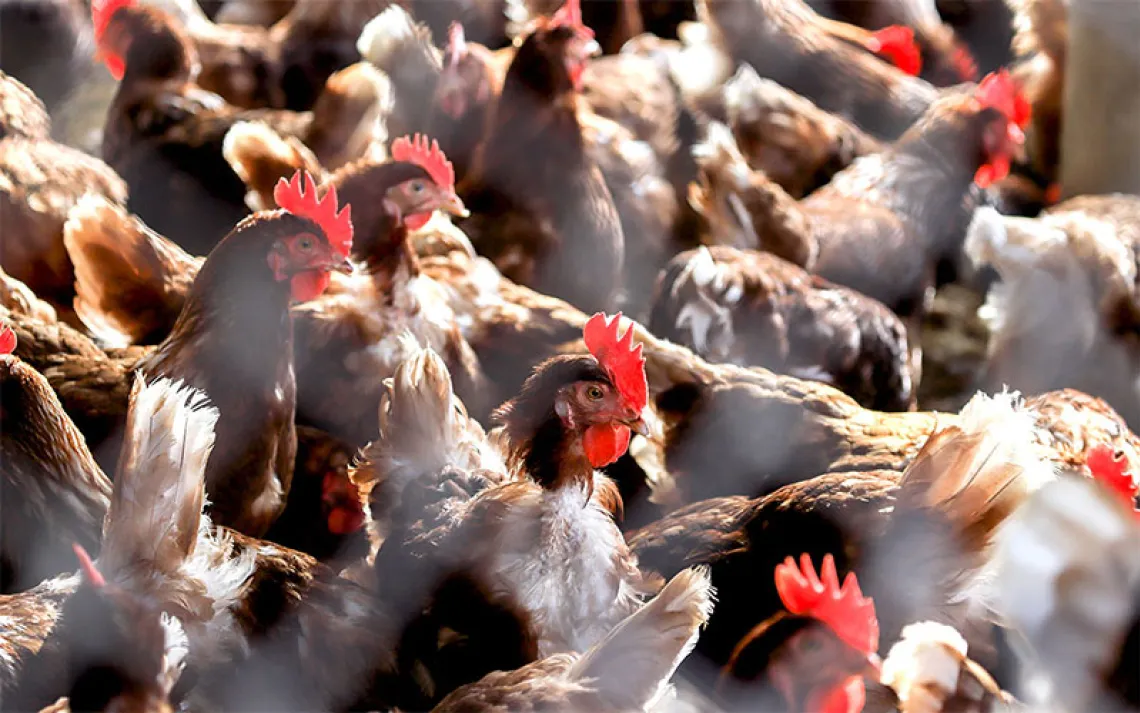Innovators Compete for $100,000 to Revolutionize Global Food Systems
The inspiration for each of their ideas? Nature.
“Can you imagine buildings that could produce oxygen, absorb CO2, and use and recycle stormwater efficiently—like how nature would do it?” asks Anamarija Frankic. Last month, the biology professor traveled from her native Croatia to San Rafael, California, to pose many such questions at Bioneers 2017, an annual gathering of environmental and social innovators.
Biomimicry—from the Greek bios for “life” and mimesis, meaning “to imitate”—is the idea that the natural world can be used as a model for human designs, and it’s among the core inspirations for the 3,000 people who converge at Bioneers each year to discuss nature-inspired solutions to social and environmental challenges.
This year’s conference also served as the culmination of the second annual Biomimicry Global Design Challenge, during which teams around the world came up with innovations to improve food systems. The $100,000 grand prize drew hundreds of entries addressing food waste, food preservation, packaging, energy use, hunger, urban agriculture, and more.
The design challenge is sponsored by the Biomimicry Institute, and the Ray C. Anderson Foundation, which was established to honor the late Ray Anderson, a Georgia carpet baron and industrial engineer. After he read Paul Hawken’s The Ecology of Commerce, Anderson halved the ecological footprint of his company, Interface Carpets, by reducing production waste and eradicated his company’s need for dyes and toxic adhesives.
On Saturday, October 24, the six teams took the Bioneers stage and stood before thousands of environmental advocates (and some potential investors) to learn which would receive the grand prize. While only one team went home with the $100,000 Ray of Hope Prize, each received some funding for their projects. In presenting the prizes, Ray C. Anderson’s grandson, John Lanier, expressed his belief that each “radical innovator” who entered the challenge has the power to transform tomorrow’s food systems.
Read on to meet these radical innovators.
B-ALL: Textile designer María José Leaño was sitting under a tree one day in her hometown of Bogota, Colombia, when she became enchanted by its spherical seeds. “Pittosporum undulatum fruit seeds open automatically; they don’t need any help,” she explains, adding, “It struck me as the perfect form of food packaging.” At the time, Leaño’s country was experiencing a drought so devastating to Colombians’ food supply that charities were dispatching emergency aid to vulnerable communities. “I knew we’d be seeing a lot more disasters,” she says, citing climate change, “so I thought, ‘Maybe we could prepare portable food to help these people—but without all the usual plastic.”
Leaño got together with some other materials-minded biomimicry enthusiasts—Paula Esguerra, Laura Mancera, and Brandon Sandoval—and eventually discovered a way to enclose prepared food using a novel form of packaging: food. The B-All is fully edible compact sphere—designed to protect food throughout the journey from producer to consumer—that closely resembles pittosporum seeds. The team is currently developing various recipes (Leaño’s favorite, based on a traditional Colombian soup called Ajiaco, consists of potatoes and corn wrapped in Guascas leaves), but B-All started as a simple rice-and-bean ball encased in plantain leaves. “Three balls make a meal for a child; four for an adult,” says Leaño.
SHareEET: Sociologist Ambra Venturini got together with fellow Italian Giuliana Gheza, a social designer (someone who designs spaces with an eye toward human wellbeing and sustainability) to figure out ways to shift attitudes around food waste. Seeking models of organisms that share resources equitably, they landed on the white-fronted bee-eater, a bird native to Africa. “Younger birds in their communities will sacrifice themselves when older birds are in need,” Venturini says, “which showed us that altruism is really important in a context with limited resources.” She and Gheza also found inspiration in mycorrhizal fungi—which help facilitate the exchange of carbon, nutrients, and water among plants.
These inspirations came together in ShareEET, an experiential dining model (that is, a restaurant concept) that Venturini and Gheza have brought to life in the form of several social experiment-oriented workshops, and a pop-up prototype in London. Here’s how it works: When guests place their orders, the ShareEET interface presents the restaurant’s resource quantities, and ingredients’ local and seasonal factors. If you order more than you need, there may be no food left for the next customer—to the extent that the restaurant might have to shut down, leaving everybody hungry. “But if sustainable choices are made, the restaurant will stay afloat,” Venturini says.
The idea is to attune consumers to the seasonality, locality, and quantities of their food choices, and change behavior accordingly. Team ShareEET plans to run 12 more social experiments to collect more data about participants’ feelings, actions, and choices—and to develop a workshop tool kit, so that communities, school dining halls, and office cafeterias can implement a food waste-reduction dining model.
Slant: Santiago, Chile, recently underwent a transition that hit the United States decades ago—more and more people are now shopping at supermarkets. “Even though people prefer the prices and quality of regular old farmers’ markets, supermarkets are always open, and usually convenient,” says Laura Cussen, a Chilean biologist who notes that supermarkets are also typically a lot less conducive to seasonal eating. “As a culture, we’re forgetting when orange season is, or that there’s no such thing as a ‘normal’ tomato—the current generation is getting used to cosmetically perfect, watered-down produce.” Along with Slant team members Aníbal Fuentes Palacios, Carla Muttoni, Francisco Humeres, Jose Hernández, Paolma González Rojas, and Agustina González Cid, Cussen wondered how to get people to buy seasonal provisions from local producers. “We asked ourselves, ‘How does nature spread useful information about food, and how to get it?”
It didn’t take long for the team to land on ants, which communicate horizontally, via pheromones and in real time, about sources of food. In ant colonies, individual actions lead to better collective decisions about how the colony finds food, based on the quality, reliability, and availability of resources. “Nature rewards cooperation,” Cussen says.
This was the basis for Sobremesa, team Slant’s mobile app that mimics ants’ modes of communication by connecting consumers (those who desire food products) with producers (farmers, fishers, bakers). Sobremesa, the Latin American term for the post-meal period of digesting and socializing, allows users to make food decisions that are informed by the surrounding community. Sobremesa users can use the app to rate the quality of a given food source (say, a roadside fruit vendor, a local butcher, or even a ripe plum tree in a public place) and indicate how it was produced. This data is then used to help direct others to quality food sources.
Aside from coordinating actions between community members and showcasing local food producers, Sobremesa aims to make up for supermarkets’ lack of transparency around food. “People can indicate their personal preferences when they create an account,” Cussen explains. “Maybe you have an allergy, or it’s important to you to always avoid palm oil. When you look up a certain type of food—eggs or tomatoes or whatever—the app ranks what’s locally available, specifically according to your values.” Team Slant is now refining and beta-testing Sobremesa.
Evolution’s Solutions: This year’s third-place winners—Cameron Ravanbach, Cliff Kapono, Jack Bernstein, and Luca De Vivo—met playing water polo for the University of California, San Diego. While traveling to the NCAA finals, they got to talking about their shared interest in hydroponics. “We started tinkering around with backyard systems, trying to figure out how we could take food scraps, and turn it into food that plants could use,” says Bernstein, then an undergraduate studying Earth systems. This quest brought them to cyanobacteria—a class of bacteria that both photosynthesize and are nitrogen-fixing.

Make every day an Earth Day
Get articles like this one sent directly to your inbox.
With this action you affirm you want to receive Sierra Club communications and may vote on policy designated by the Sierra Club Board.
“We took inspiration from the fact that nature always recycles its waste,” says De Vivo, a structural engineering Ph.D. candidate. The team designed a multi-compartmental, solar-powered growing space that extracts nutrients from compost via a series of filters through which home food waste can be fed into the multi-layer, poly-culture hydroponic unit. This reduces the need for constant water input and synthetic fertilizers. And there’s a biomimetic two-fer: the design replicates avian respiratory systems. “We looked at how birds breathe,” De Vivo says, “and found that there’s only one way for air to enter and leave.” Evolution’s Solutions’ control system can help farmers automate and optimize plants’ intake of nutrients, light, and water.
Team Evolution’s Solutions has already come a long way from the UCSD swimming pool—and the third-place prize pot of $15,000 will bring the group further to its goal of, as Bernstein puts it, “trying to move out of the backyard.”
Windchill: Jorge Zapote, Mitchell Weber, Xi Cheng, and Michelle Zhou are undergrads at the University of Calgary, and one snowy winter day they found themselves marveling at the fact that despite the sub-zero temperatures, most people in Canada still use energy-guzzling refrigeration to preserve their food. How to rely less on the grid—especially in impoverished areas with poor access to electricity.
The students’ conversation soon veered into elephants and bees, two of many species that benefit from evaporative cooling mechanisms, activated by, respectively, the flapping of ears and the beating of wings. “We also thought about the insulative properties of soil, and the fact that the deeper you dig into the soil, the more temperature gets regulated,” Weber says. “Burrowing into dirt is how meerkats and termites and kangaroos stay cool.”
All this evolved into the Windchill prototype, which looks like a garden-variety picnic cooler, but comes equipped with a passive intake structure to draw ambient air and wind into a funnel that sends it underground, where it cools. Then, that same air goes into the system’s evaporation chamber, where a pipe is immersed in water. The fluid evaporates around this pipe, and an internal fan disperses cool air throughout the Windchill, effectively keeping food cool for long periods of time. “We’re hoping to collaborate with NGOs and governments to help feed people off the electrical grid, but also to create a commercial product for people who like to go camping or paddling for long periods of time, and don’t have access to ice,” says Weber, who cites the company Biolite, which develops cookstoves that are used by both outdoor adventurers and residents of poor nations, as an inspiration. Team Windchill will be using its second-place prize winnings of $20,000 to prototype its product commercially.
 NexLoop: This motley team—comprised of biologist Anamarija Frankic, urban farmer C. Mike Lindsey, and architecture student Jacob Russo—took home the grand prize. Their innovation? The AquaWeb, a modular water sourcing and management device designed to help urban food producers harness atmospheric moisture (rain, fog, and even humidity) and distribute it to plants in greenhouses, indoor vertical farms, container farms, and other types of urban farms. Urban farmers can simply adhere the AquaWeb—an 18-inch-tall hexagonal structure made out of bioplastic created from cornstarch, and designed in the image of a dwarf honeybee’s nest—to building facades and network rainwater into hydroponic food production.
NexLoop: This motley team—comprised of biologist Anamarija Frankic, urban farmer C. Mike Lindsey, and architecture student Jacob Russo—took home the grand prize. Their innovation? The AquaWeb, a modular water sourcing and management device designed to help urban food producers harness atmospheric moisture (rain, fog, and even humidity) and distribute it to plants in greenhouses, indoor vertical farms, container farms, and other types of urban farms. Urban farmers can simply adhere the AquaWeb—an 18-inch-tall hexagonal structure made out of bioplastic created from cornstarch, and designed in the image of a dwarf honeybee’s nest—to building facades and network rainwater into hydroponic food production.
“Initially, we were interested in plant surfaces’ hydrophilic, or water-absorbing, properties,” says Russo, who borrowed water-storage inspiration from the drought-tolerant ice plant. “Its epidermal water reservoirs provided us with a small-scale, decentralized water collection model.” The team also studied how cribellate orb weaver spiders collect fog from the air with their webs. The AquaWeb’s vertical membrane provides additional surface area for water collection and storage, and a capillary-like system within the module passively delivers water to the organic roots of edible plants. In figuring out how to distribute the water, the team turned to fungi; specifically, the Jersey cow mushroom, which transports fluid between the root systems of neighboring plants.
“Our vision is a food-water nexus capable of sustainable, closed-loop urban living,” says Lindsey. “We intend to scale up to facilitate building-wide adoption and citywide integration of the system to offset the needs of imported water from local water districts and regional sources, reduce the amount of water entering sewage systems, and decrease street runoff into cities’ rivers.”
With the $100,000 prize in hand, Team NexLoop is working to pilot its all-in-one water sourcing and management system with urban farmers in New York, which gets about three to four inches of rain, on average, per month—enough for farms to self-sustain, according to the team. “Our goal is to help urban food producers conserve energy and water, become more resilient to shortages and natural disasters, and passively harvest the sky,” says Russo.
*
The next round of the Global Design Challenge has just launched, meaning enterprising biomimicry designers have another opportunity to compete for the $100,000 Ray of Hope Prize. The 2018 year’s challenge? Climate Change: Reversal, Adaptation, and Mitigation. Learn more here.
 The Magazine of The Sierra Club
The Magazine of The Sierra Club




